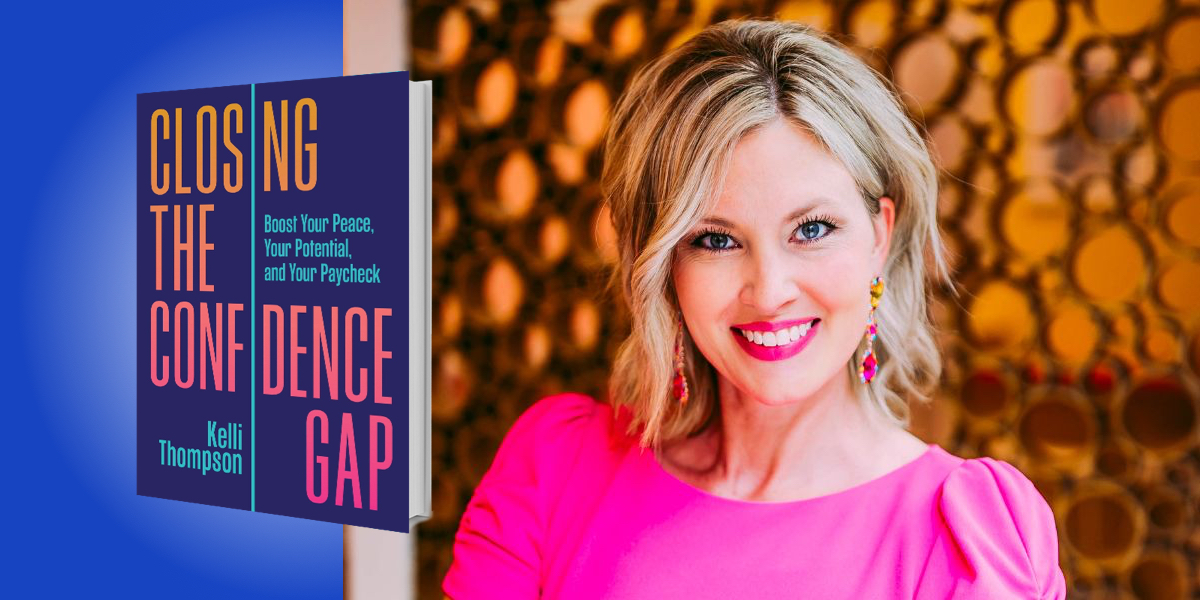Kelli Thompson has coached and trained hundreds of women to trust themselves, lead with more confidence, and create a career they love. She is the founder of the Clarity & Confidence Women’s Leadership Program and a Stevie Award® winner for Women in Business—Coach of the Year. Kelli has contributed to many publications including Forbes, Business Insider, Fast Company, HuffPost, MarketWatch, and Parents.
Below, Kelli shares 5 key insights from her new book, Closing the Confidence Gap: Boost Your Peace, Your Potential, and Your Paycheck. Listen to the audio version—read by Kelli herself—in the Next Big Idea App.

1. We need more women leaders in the rooms where decisions are made.
What would you do if you had more confidence? Would you change careers, ask for a raise, run for office, speak your mind, or start a business?
When I asked almost 500 women this question, I heard these answers, but doubt and imposter feelings held women back. Research confirmed my observations—there is a confidence gap. A study at Wharton Business School found that women tended to outperform men on a standard test, but men felt more confident than women in their performance. In addition, men were more likely to self-promote their efforts, which led to more job offers and higher starting salaries.
In 2021, women held just 6 percent of CEO positions in the United States, and only 24 percent of C-suite leaders are women. Women of color remain embarrassingly underrepresented at every level of leadership. With systemic gender equality gaps in the workplace today, it’s no wonder that so many women undervalue themselves and their abilities.
In my own corporate tenure, I worked at organizations voted best places to work for mothers, yet there were no women in the C-suite. The unconscious message was clear: I had great benefits, but I wasn’t invited to lead beyond a certain rung of the ladder. I felt helpless to change it.
To close the confidence gap and see more women showing up in their full potential at work, it’s not just about building self-confidence. The systems at work need to place more women leaders at the top of organizations. Research shows that hiring women into leadership positions helps associate women with successful leadership traits, and it results in improved company profitability.
2. Stop overestimating others’ intelligence and underestimating your own.
When my daughter was four, she developed a condition I call the but firsts. When I would ask her to do something, she’d immediately respond with, “Mom, but first I need to __________” (get a drink, put on socks, brush my doll’s hair, etc.). It was her special way of stalling an activity that brought her discomfort, like cleaning her room.
“It’s healthy to feel doubt and it’s also likely that you’ll feel it any time you stretch your comfort zone.”
The thing is, we never grow out of the but firsts—they just get more sophisticated. We cite all the reasons why we aren’t ready to speak up, go for the promotion, or start the side hustle (but first I need to get more experience, go back to school, wait for the right time, etc.) We can feel on the verge of being “found out” as unqualified, just lucky, or a fraud. These feelings describe imposter syndrome. But is our normal human doubt being reframed as imposter syndrome? It’s healthy to feel doubt and it’s also likely that you’ll feel it any time you stretch your comfort zone.
Research finds that 70 percent of people experience imposter syndrome at some point in their career. Everyone feels doubt, but imposter syndrome tends to get labeled as a “women’s issue.” However, data shows that people report more intense imposter feelings when they’ve experienced racial discrimination, or brilliance is prized above all else at work.
Resolving imposter feelings is a both/and issue. We need to fix the systemic issues that perpetuate it while also providing support and validation to work with these feelings. We can start by remembering we cannot criticize our way into more confidence, and compassionately normalize these feelings.
Leaders of all levels experience these feelings (even if they hide them well). How often have you put these leaders, or colleagues, on a pedestal by believing that they know better than you? This may cause heightened self-doubt and staying more silent than you want to be. With myself and my clients, I lovingly call this pedestal syndrome. Pull the pedestal.
3. Know what you stand for so that you don’t fall for everything.
If you are high-achieving and focused, it’s easy to get caught up in checking all the boxes and climbing ladders. We don’t think to stop and ask, do I even want this? I’ve been there. My clients have been there. Climbing the ladder of success, only to get to the top and find that it’s leaning against the wrong building. When you find this out, it sucks.
The system of work was designed for men, by men, when women stayed home. So, it can be easy to unconsciously fall in line with copying a leadership approach that may not align with our unique style and values. It can be seen as normal to conform to a culture of hustling and overworking. This conformity kills confidence.
“It can be seen as normal to conform to a culture of hustling and overworking.”
Knowing your values gives you greater discernment—not between right and wrong, but between what looks right and what is right. In your work, there will be ambiguity, competing goals, and people conflict. There will be competing schedule demands and critical budgeting decisions. There are many colleagues and bosses who have opinions on your career. People are eager to give advice, and it’s tempting to go along with popular opinion. Knowing your values helps you choose between your yes and no, no matter what’s popular, culturally appealing, or demanded.
4. Dump unpaid work and shift from doer to leader.
When I was in corporate America, when we promoted people from employee to leader we assumed a magic transformation would happen—that they’d shed the identity they had as a doer and transform into a leader who was comfortable coaching, delegating, and making hard decisions.
This is especially challenging for women who navigate an extra layer of challenges, like unpaid workload. According to research published by Harvard, women received 44 percent more requests to volunteer at work than men. Many of these requests were for non-promotable tasks. I can recall many instances when I was called to lead fundraisers or committees, which took significant time and effort for the promise of “exposure.” Unfortunately, that exposure didn’t materialize into performance review mentions or additional compensation.
First, organizations need to evaluate the policies that keep women stuck in doer mode, including inequitable distribution of unpaid office work (i.e., notetaking and party planning).
Second, women have permission not to be the person that’s constantly rushing in to save the day at home or work. It’s hard to build sustainable confidence if you’re consistently overworked and overwhelmed. Saying no builds as much confidence as saying yes. Slow down and ask, Is this truly a development opportunity for me? Who else would benefit from it? What does support—without takeover—look like from me? What non-promotable work can be outsourced?
Every conversation teaches people what you will tolerate and what you won’t. You have the opportunity in every conversation to set the tone for your leadership, for the team, and for yourself. This ultimately grows everyone’s confidence.
5. To close the gender pay gap, we need to normalize money conversations.
I was a curious kid who also didn’t mind asking my parents about adult topics, like how much their house payment was, how my baby sister was born, and how much money they earned. I can still hear my mother’s well-meaning words to me: “Honey, it’s not polite to talk about money, and you definitely shouldn’t ask people what they make.”
“The more women get comfortable talking about money, both in their personal finances and with employers, the better chance there is to close the gaps.”
So many of the messages about salary started in our families but continue in the workplace. For women, this is expensive as the wage gap continually shows women are paid less than men. A 2016 study from Columbia University looked at the mental health consequences of gender wage gaps and found that when women make less money, they’re 2.4 times more likely to experience depression and 4 times more likely to have anxiety.
My personal experience as an HR professional confirms much of what the data reveals: Women hesitate to apply for roles they are fully qualified for, ask for lower starting salaries, and negotiate less often than men. Then that lower-than-market salary impacts confidence and well-being. But it’s not just on women to close the gap. Governments and corporations must examine their systems, improve transparency, and remove barriers to pay equity.
About 52 percent of women say they talk about money with friends, compared to 61 percent of men, according to U.S. Bank. The more women get comfortable talking about money, both in their personal finances and with employers, the better chance there is to close the gaps. There are five money conversations every woman needs: challenge the systems, notice self-talk, negotiate salary, evaluate savings, and ask for support for professional development. Know your worth and make your asks.
To listen to the audio version read by author Kelli Thompson, download the Next Big Idea App today:































